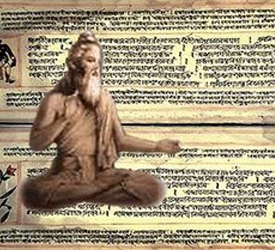Vedo Rakshati Rakshitaha

Vedic Concepts
Veda is divided into four major parts viz, Samhitas (prayers), Brahmanas (rituals), Aranyakas ( meditations) and Upanishads (The knowledge of self). The first three (Samhita, Brahmana & Aranyaka) are collectively called as Veda Purva (Starting) and the last one Upanishad is called as Veda Anta (ending) or Vedanta. The Veda Purva is also referred as Karma Kanda (Portion dealing with Rituals & Activities) and Vedanta as Jnana Kanda (Portion dealing with The Knowledge of Supreme Self).
The key driver behind this division is the type of life style of the human being ; the first one being a life of activities and second one , a life of renunciation. These are also called as Pravritti Marga (Activity/Progressive Path) and Nivritti Marga (Resolution/Renunciation Path). The knowledge on Veda Purva caters for the Pravritti Marga and the Vedanta for Nivritti Marga. As obvious, the Karma Kanda acts as a guiding scripture for Pravitti Marga and Jnana Kanda for Nivritti Marga.
Vedas did not have any script, as the knowledge was propagated only through teaching and listening. This method is also referred as “Karna Parampara”. The whole concept of writing came into existance only when the powers of human faculty were degraded over time and he had to refer to records to recollect things. (This degradation even now continues, as we see now a deplorable situation that we are forced to use the computers or other medium to record. It is a sad state to see that these Vedas had to be now known to through the internet.) The oldest records of Vedas were found in Brahmi scripts carved on stones. These scripts were in pictorial form and the predecessor to the Devanagari script in use now and also called as “ Samskritham” or Sanskrit as a short form in English language. These were also subsequently recorded in ancient times on dry palm leaves (The most reliable and available printing medium at that point of time).
The Vedas have guided Indian civilization for thousands of years. They are the pillars of Hinduism. "Veda is the source of all Dharma" declares Manusmirti (2.6.) There is no major religion on the planet, which has not been influenced by the Vedas. The creation stories of all major religions are based on Vedas. Though all other religions have forgotten their Vedic root or have been forgotten, there is one religion, Hinduism, that has kept the flame of the Vedic wisdom burning continuously. Vedas which means ' knowledge' contain a good deal of scientific knowledge that was lost over millennia, which needs to be recovered. The Vedic sages had discovered the subtle nature of reality, and had coded it in the form of the Vedas.
According to Raja Ram Mohan Roy, author of Vedic Physics, "The knowledge contained in the Vedas is very abstruse, and is well beyond the comprehension of ordinary human beings. Therefore Vedic sages coded the knowledge in a simple form in which it could be understood by everyone. The Rig Veda itself testifies that it has a hidden meaning in verse 4.3.16. Sage Bharata in his Natyasastra 2.23 refers to the sages who knew the hidden meaning of the Vedas. This coding of knowledge proved to be very successful in disseminating the knowledge to common folks. This would also explain why extraordinary steps were taken to preserve the Vedas, and the honor given to the Vedas by Hindus, even though its meaning is little understood today. "On the eve of the "Mahabharata War" our ancestors believed that their knowledge was in danger of being lost. They could have written it down, but writings could be destroyed. Therefore, it was memorized and passed on orally. Today, the Avesta, religious scripture of ancient Iranians, only a fraction of it is available. Alexander captured Iran in 326 B.C. and after a bloody war, destroyed each copy of the Avesta available."
